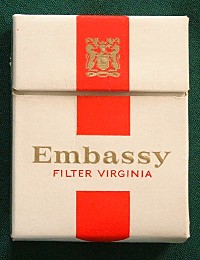Smoking and the 70s

Cigarettes were a big part of life in the 70s. People smoked them in large numbers. They also started to kick the habit in large numbers too. To give up or not, and to inhale or not, were big topics of conversation.
In 1969, Embassy Filter (right) was the most popular brand. It had been introduced in 1962 and took a staggering 24% of the cigarette market in 1968. [1] By 1971 though, it was knocked off the top spot by Players No 6. [2]
In 1972 these brands (below) made up 94% of all cigarettes sold (in order of tar content, lowest first):
- Silk Cut (filter)
- Consulate Menthol (filter)
- Cadets (filter)
- Piccadilly De Luxe (filter)
- Cambridge (filter)
- Embassy Gold (filter)
- Embassy Regal (filter)
- Sovereign (filter)
- Sterling (filter)
- Player's No 6 Virginia (filter)
- Park Drive (filter)
- Kensitas (filter)
- Embassy (filter)
- Gold Leaf Virginia (filter)
- Player No 6 (plain)
- Player's Weights (plain)
- Albany (filter)
- Woodbine (plain)
- Player's No 10 Virginia (filter)
- Guards Tipped (filter)
- Benson & Hedges King Size (filter)
- Senior Service (plain)
- Player's Navy Cut (plain)
- Park Drive (plain)
- Rothman's King Size (filter)
Source: "Which?" published by The Consumers' Association September 1971, page 283
The majority of the most popular brands are filter tipped. At the time people wanted to believe that the filter would protect them. Medical research showed otherwise, even as early as the 60s. Also worth noting is that Rothman's advertised their cigarettes as for "...when you know what doing are doing" - a bit ironic considering the tar content!
In 1970, 55% of men and 44% of women smoked cigarettes. The percentage smoking cigarettes had fallen from the peak of 65% in 1948 and the risks of smoking on health were beginning to slowly sink in. In spite of research by the late Professor Sir Richard Doll published in 1951, which linked smoking with lung cancer, cigarette smoking was so much a part of life that the habit died hard. Even as late as 1973 the Guinness Book of Records described nicotine as an "anodyne to civilisation".

In 1971, cigarette manufacturers agreed to put a mild health warning on the packets (left) - "WARNING by HM Government SMOKING CAN DAMAGE YOUR HEALTH". I say "mild" because Professor Sir Richard Doll's research showed that of 1,357 men with lung cancer, 99.5% were smokers. Or as "Which" chillingly put it - you had as much chance of dying before you were 44 if you smoked, as a serviceman had of being killed in the Second World War. [3] Most people were still playing Russian Roulette and hoping that the chamber was empty.
"Which" never published a report comparing one cigarette brand with another. They acted in the best interest of consumers and recommended only that people should give up. There were conflicting stories circulating concerning the safety of other forms of smoking, such as pipe or cigar smoking: "Was it safer than cigarettes?", "Was it safe if you didn't inhale?" and "Was it worth waiting for a safe cigarette?". "Which" did not sit on the fence and told members as directly as possible that the only safe course of action was to give up.
The 70s was the decade when people did finally accept the risks of smoking and the proportion of the population who smoked fell quite significantly. Those leading the way were the professional middle classes. The anti-smoking group, ASH, was founded in 1970 and took a lead in alerting the public to the dangers of smoking. The proportion of men and women smoking cigarettes dropped gradually during the 70s. By 1980, 42% of men and 37% of women smoked. (Today's figures are 27% and 25% respectively).
Read more:
- Cigarette smoking in the 1950s - USA
- 60s cigarette culture - UK
- Vintage cigarette packets - UK
- Players No6 - part of the British scene?
References
[1] The Guinness Book of Records, Seventeenth Edition, published October 1970, pages 155-6
[2] The Guinness Book of Records, Nineteenth Edition, published October 1972, page 152
[3] Source: "Which?" published by The Consumers' Association September 1971, page 280


Comments
Great post!! This is very informative post for me. Thanks for sharing, sure I will bookmark your website for future revisiting. Thanks once again.
I remember Joysticks from the war years. My two big brothers got involved in the black market and would obtain their supplies from the nearby US base in Yorkshire. I once opened a sideboard and found it full of packets of Joysticks. I was forbidden to tell anyone under threat of a severe beating! They cleaned up as no-one had seen these double length fags before!